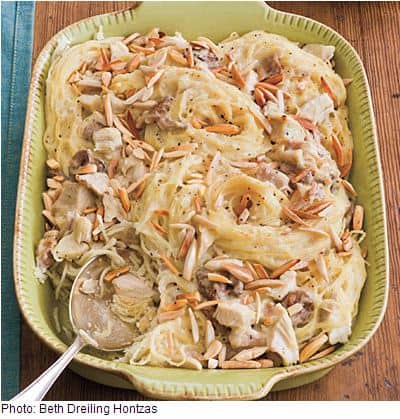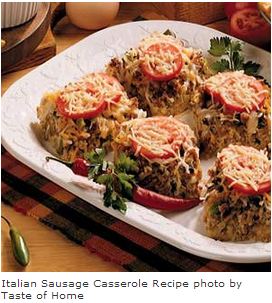We’re all familiar with the potluck supper. It’s an American culinary tradition. But, the word pot-luck actually first appeared in 16th century England and referred to “food provided for an unexpected or uninvited guest, the luck of the pot.” In America the concept of a communal meal where guests supply some of the food appears to have originated in the late 19th century particularly in the Western United States.
Modern potluck dinners are often organized by church or civic groups, since they simplify meal planning and distribute the costs among the participants. But neighborhoods organize them too as well as bridge clubs, book clubs, etc. The only rule is that each dish is ample enough to be shared. In some cases each participant agrees ahead of time to bring a single course and the result is a multi-course meal.
Lately, potluck dinners, brunches, and even potluck wedding receptions are being hosted as alternatives to traditional catered events. While the idea of a potluck remains the same, gone are those 1950s green jello molds. Today’s cuisine options are international and many potluck events have evolved into something a lot more sophisticated than mac-n-cheese casserole, a platter of friend chicken, a vat of green beans and a basket of biscuits on a sideboard. Although, I must admit, that menu sounds pretty good to me. But, look at these variations for inspiration.
Safari Supper
 This is a progressive meal. A group of neighbors rotate, move among different houses for each part of the meal. Typically, this involves the preparation of one course only (a starter, main course or dessert, etc.), and visiting different neighbors for the other courses. Although it does require careful and complex planning, the idea is relatively straightforward: for example, Neighbor A makes a starter, and is visited by Neighbors B and C. After this, Neighbor A moves to a different house, Neighbor D, and is joined by Neighbor E. Neighbors B and C go on to different houses also, but not the same one. Finally, a similar pattern for dessert: Neighbor A moves to Neighbor F’s house, joined by Neighbor G. This is a great way for neighbors to socialize in an informal way. But someone has to be responsible for traffic control.
This is a progressive meal. A group of neighbors rotate, move among different houses for each part of the meal. Typically, this involves the preparation of one course only (a starter, main course or dessert, etc.), and visiting different neighbors for the other courses. Although it does require careful and complex planning, the idea is relatively straightforward: for example, Neighbor A makes a starter, and is visited by Neighbors B and C. After this, Neighbor A moves to a different house, Neighbor D, and is joined by Neighbor E. Neighbors B and C go on to different houses also, but not the same one. Finally, a similar pattern for dessert: Neighbor A moves to Neighbor F’s house, joined by Neighbor G. This is a great way for neighbors to socialize in an informal way. But someone has to be responsible for traffic control.
Rota
Another variation on the potluck dinner is the rota meal. Participants take turns providing food for the entire group, rather than each participant bringing a dish. For regular meals with a fairly consistent set of participants, this dramatically reduces the amount of preparation required.
Today’s potluck can be quite inspired and original, although being a neurotic Jewish chef I have to make sure every dish is color coordinated and not all soft, cheesy noodle dishes. Your planning can be simple: Come up with a theme. For a gathering of women my friends call Tribe, we set a theme such as “breakfast for dinner” or “spring fling” and begin organizing the menu by email. For those in the group that don’t cook, there are take-out options at grocery stores or restaurants. If you attend or host many potlucks throughout the year, owning a warming tray is always helpful and quite inexpensive. Here are a few potluck recipes that are my favorites.
Eggplant Parmesan
(main dish or side)
2 large eggs
3/4 cup Italian breadcrumbs
3/4 cup finely grated Parmesan, plus 2 tablespoons for topping
1 teaspoon dried oregano
1/2 teaspoon dried basil
Coarse salt and ground pepper
2 large eggplants (2 1/2 pounds total), peeled and sliced into 1/2-inch rounds
6 cups (48 ounces) store-bought chunky tomato sauce or homemade chunky style tomato sauce
1 1/2 cups shredded mozzarella
Preheat oven to 375 degrees. Brush 2 baking sheets with oil; set aside. In a wide, shallow bowl, whisk together eggs and 2 tablespoons water. In another bowl, combine breadcrumbs, 3/4 cup Parmesan, oregano, and basil; season with salt and pepper. Dip eggplant slices in egg mixture, letting excess drip off, then dredge in breadcrumb mixture, coating well; place on baking sheets. Bake until golden brown on bottom, 20 to 25 minutes. Turn slices; continue baking until browned on other side, 20 to 25 minutes more. Remove from oven; raise oven heat to 400 degrees. Spread 2 cups sauce in a 9-by-13-inch baking dish. Arrange half the eggplant in dish; cover with 2 cups sauce, then 1/2 cup mozzarella. Repeat with remaining eggplant, sauce, and mozzarella; sprinkle with remaining 2 tablespoons Parmesan. Bake until sauce is bubbling and cheese is melted, 15 to 20 minutes. Let stand 5 minutes before serving.
Chicken Tetrazzini Casserole
 Coarse salt and fresh ground pepper
Coarse salt and fresh ground pepper
6 tablespoons butter
1 pound white mushrooms, trimmed and sliced 1/4 inch thick
1/2 cup all-purpose flour
3 cups milk
1 can (14.5 ounces) reduced-sodium chicken broth
3/4 cup dry white wine
3 cups grated Parmesan cheese
1/2 teaspoon dried thyme leaves
1 pound linguine, broken in half
1 rotisserie chicken, skin removed, meat shredded (about 4 cups)or leftover turkey
1 package (10 ounces) frozen peas, thawed and drained.
Preheat oven to 400. Bring a large pot of salted water to a boil (for
pasta). In a large saucepan, melt 2 tablespoons butter over high
heat. Add mushrooms, and season with salt and pepper. Cook,
tossing frequently, until tender and browned, 8 to 10 minutes.
Transfer to a bowl, and set aside. In same saucepan,
melt remaining 4 tablespoons butter over medium heat. Add flour;
cook, whisking, about 1 minute. Whisking constantly, gradually add
milk, broth, and wine. Bring this sauce to a boil; reduce to a simmer, and add 2 cups Parmesan and thyme. Season with salt and pepper.
Cook pasta 2 minutes less than package instructions for al dente; drain and return to pot. Add sauce, chicken, peas and mushrooms. Toss
well to combine. Divide between two shallow 2-quart bakingdishes; sprinkle with remaining Parmesan. Bake until browned, about 30
minutes. Let stand 10 minutes before serving.
Italian Sausage Casserole
(brunch, breakfast or themed dinner)
 1 pound Italian sweet sausage, casings removed
1 pound Italian sweet sausage, casings removed
1/2 cup chopped shallots
2 garlic cloves, minced
1/2 cup chopped drained oil-packed sun-dried tomatoes
4 tablespoons chopped fresh parsley
5 large eggs
3 large egg yolks
1 cup half and half
1 cup whipping cream
2 cups grated mozzarella cheese
1/2 teaspoon salt
Preheat oven to 375 degrees. Butter 13x9x2-inch glass baking dish. Sauté sausage in medium nonstick skillet over medium heat until brown and cooked through, breaking up with back of fork into small pieces, about 10 minutes. Add shallots and garlic and sauté 3 minutes. Add sun-dried tomatoes and 2 tablespoons parsley; stir 1 minute. Spread sausage mixture in prepared dish. (Can be made 1 day ahead. Cover and refrigerate.)
Whisk eggs, egg yolks, half-and-half, whipping cream, 1 1/2 cups cheese, and salt in large bowl to blend well. Pour egg mixture over sausage mixture in dish. Sprinkle remaining 1/2 cup cheese and 2 tablespoons parsley over. Bake until top of casserole is golden brown and knife inserted into center comes out clean, about 30 minutes. Let stand 5 minutes before serving.
